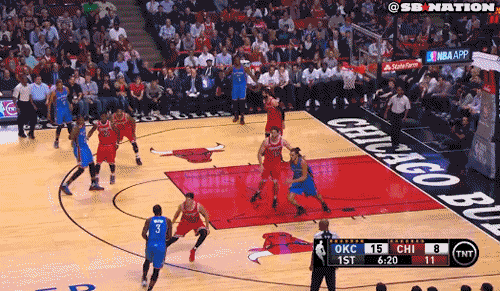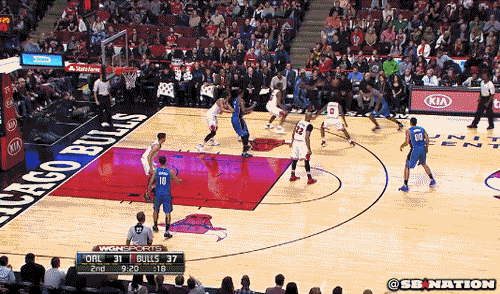Doug McDermott’s been playing his best basketball lately. What does it mean for Bulls now and in the future?
Though he didn’t have much of an impact in two-straight losses to the New York Knicks, the Chicago Bulls have to be encouraged by the recent production they’ve been getting out of last year’s first-round pick Doug McDermott.
Acquired in a draft-day trade last year (16th and 19th pick in the first round plus a future second-round pick), McDermott couldn’t find consistent minutes last year under Tom Thibodeau—battling injuries and Thibs’ aversion to playing rookies/subpar defenders—and struggled to find a groove in Fred Hoiberg’s new offensive system.
In a particularly tough January, McDermott was only averaging 6.2 points per game on 38.1% shooting over about 22 minutes per contest, giving him by far his lowest player impact estimate (PIE) of any month this year—3.3—and marking a step back in each of those categories from a December in which he looked to be turning a corner.
Then February rolled around and McDermott started to take off.
In 12 February games, McDermott averaged 14.4 points per game—up 8.2 PPG from the previous month—on 51.6% shooting, including a 30-point outing in a win against Toronto. So far in March, he’s kept it up, averaging almost 13 PPG (46.2% shooting), cracking the 20-point mark in three straight games vs. Toronto, Washington, and Brooklyn. Specifically, since the All-Star break, McDermott has seen an uptick in minutes (25.8 to 22.4), points (14.0 to 8.2), field goal percentage (49.2% to 43.5%), and 3-point percentage (44.6% to 44.2%) per game. Aside from just looking at his basic scoring numbers, though, there are some interesting factors surrounding McDermott’s sustained success.
One interesting note is that McDermott seems to score more efficiently when he isn’t strictly trying to be a 3-point shooter. In his worst months of the season (October and January), only 27.3% and 36.4%, respectively, of his points came off of 2-point shots; in all other months, 2-pointers accounted for more than 42% of his points—which all corresponded with higher scoring averages. Aside from smart cuts to the basket and pump-fakes off of drives that lead to finishes in the restricted area, like this,
McDermott has also been showing off a nice mid-range game, shooting 43.5% on attempts from 8-24 feet. Hoiberg himself has noted McDermott’s affinity for shooting floaters when he attacks the paint, allowing him to finish safely away from shot blockers. Additionally, he’s shown an affinity for making strong cuts to the basket when people overplay his jump shot.
This threat to score closer to the basket is what makes him more than just a Kyle Korver-type shooter; though he is a great three-point shooter (6th in the league in 3-point percentage at 42.9%), he has the capability to hurt defenses even more when he scores from inside the line.
Another interesting note is that, in addition to his increased scoring output, McDermott has also been taking care of ball far better than he has at any point this season, a promising sign for a young player. While his average assist per game numbers have remained steady throughout this season, McDermott has seen huge improvement in his assist-to-turnover ratio (2.29 post-Break vs. 0.8 pre-Break).
All of this taken together, the ball has been finding him a lot these last two months on offense, and he has been showing he knows exactly what to do with it.
Unfortunately, McDermott’s increased playing time means that the ball has also been finding him more on defense, which is a big problem. While his offensive rating—the number of points the Bulls score per 100 possessions when he is on the floor—has spiked from 99.1 to 101.3, his corresponding defensive rating—points scored per 100 possessions with McDermott playing—has rising proportionally: from 103.7 to 106.0.
Unless he is chasing around a pure shooter that just runs around screens, he simply does not have the foot speed to stay in front of quicker guards nor does he have the size to keep bigs out of the post. Prime example: watch Dion Waiters barely acknowledge McDermott’s existence as he blows by him for an easy layup.

Also, defensive awareness has frequently been a problem for him…

Though these defensive issues have not resulted in a drop-off in his increased impact per game (PIE of 9.6 post-All-Star Break vs. 5.9 pre-Break), the Bulls have to figure out whether or not playing someone that has the potential to give up as many points as he gets for them is worth the risk. They already have a net deficit in points scored per game this season, giving up 103.1 points while only scoring 101.7; they can hardly afford to continue allowing teams to have their way with them on offense.
However, the Bulls also have had severe issues with stagnation on offense and desperately need some consistent perimeter shooting. Though Nikola Mirotic has been getting hot from beyond the arc of late, McDermott is by far the best shooter on the team and could perhaps be an X-factor if he continues to step up his game.
After these last two embarrassing losses to the Knicks, there may not be that many opportunities for McDermott to prove his worth this season. The Bulls currently sit at 1.5 games out of the final Eastern Conference playoff spot behind Detroit and Indiana, with one more game against both of those teams as well as dates with Atlanta, Cleveland, and Miami.
Even if the Bulls manage to miss out on the postseason this year, however, these last 11 games are going to be crucial for McDermott to prove that he belongs on this team in the future. Perhaps if he plays an instrumental role in a playoff push and then uses this momentum to have a breakout season next year, we may look back at this post-All-Star stretch as the turning point in a (hopefully) successful career.
For More Great Chicago Sports Content
Get the latest Chicago sports news, analysis, and breaking stories on the Bears, Bulls, Blackhawks, Cubs, White Sox, Sky, and more! Tap the star to add us to your favorites on Google News, so you never miss a story on your favorite Chicago teams.
Follow us on Twitter at @chicitysports23 for more great content. We appreciate you taking time to read our articles. To interact more with our community and keep up to date on the latest in Chicago sports news, JOIN OUR FREE FACEBOOK GROUP by CLICKING HERE




